Research
Outline
Diagnosis and treatment of lymphatic metastasis: a new approach to cancer treatment.
90% of cancer patients die from metastasis. And many cancer patients have confirmed lymph node metastasis. Lymph node metastasis suggests how cancer will progress in the future. Although it is an important prognostic factor, we do not yet fully understand the mechanisms underlying metastasis.

Our current research themes are:
- Experimental verification of the theory of lymph node-mediated hematogenous metastasis
- New cancer chemotherapy applied via the lymph network (lymphatic drug delivery system: LDDS)
- Studies on the activation of tumor cells in distant organs after lymph node dissection
In our laboratory, we don't stick to the default concept. We will solve the above subjects by our research and thinking processes.
Three Pillars
Non-clinical trial
1|Preclinical studies
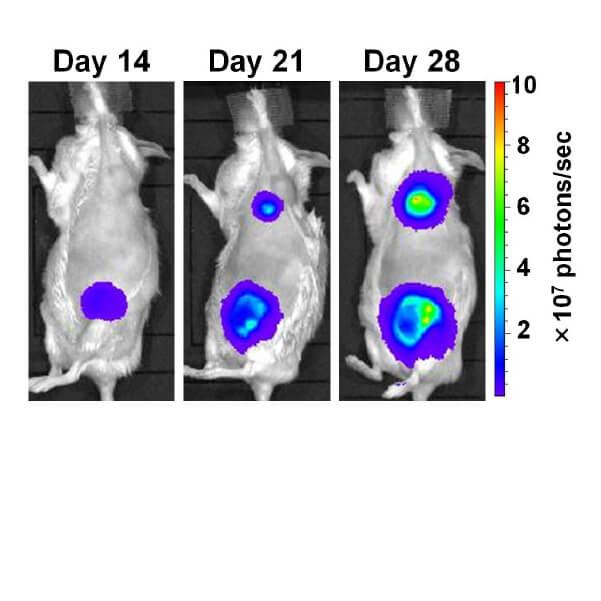
Establishment of special lymphadenopathy mice over 20 years.
Understand and elucidate the fundamental characteristics of the lymphatic network.
We investigate lymph node metastasis by experimenting on animals that live on the same principle of life as humans?
Experiments using mice, i.e., preclinical studies are the first step before clinical investigations on humans.
In this laboratory, we have established a special ‘lymph node mouse model’ whose nodes are the same size as humans (10 mm diameter). We have tailored our experimental systems for conduction fundamental studies on lymph node metastases. We have been conducting preclinical studies that have lead to clinical trials in close collaboration with clinicians.
Drug delivery system
2|Original DDS
(drug delivery system)
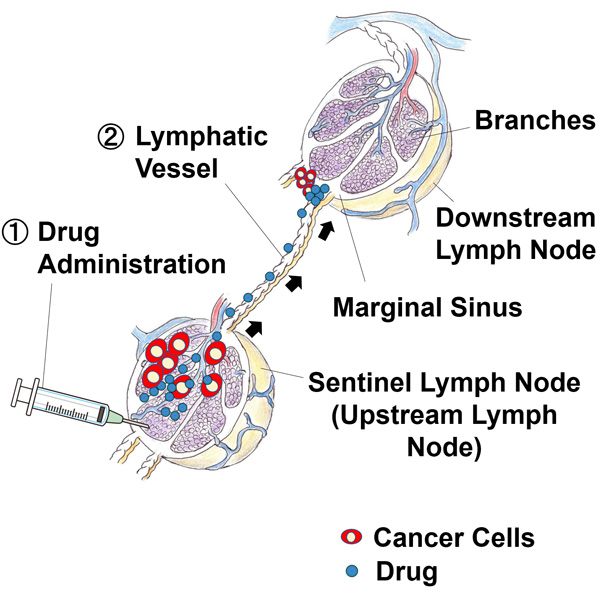
Development of a unique drug introduction method. We can treat metastatic lymph nodes by delivering tiny amounts (one drop0 of anticancer drugs thus avoiding systemic side effects.
Systemic chemotherapy using anticancer drugs is used to treat metastatic lymph nodes. However, many anticancer drugs have undesirable side effects and are not highly effective. In our laboratory, by injecting an anticancer drug directly into the lymph node, the anticancer drug can be delivered not only to the affected lymph node but also to lymph nodes located downstream of this lymph node. We have developed a lymphatic drug delivery system (LDDS) aimed at the prevention and treatment of metastatic cancer cells. With LDDS, it is possible to keep the amount of drug required to a much lower level than is possible with systemic chemotherapy.
We will soon conduct clinical trials to introduce this methodology to the clinic to treat cancer patients.
Imaging equipment
3|Image analysis equipment
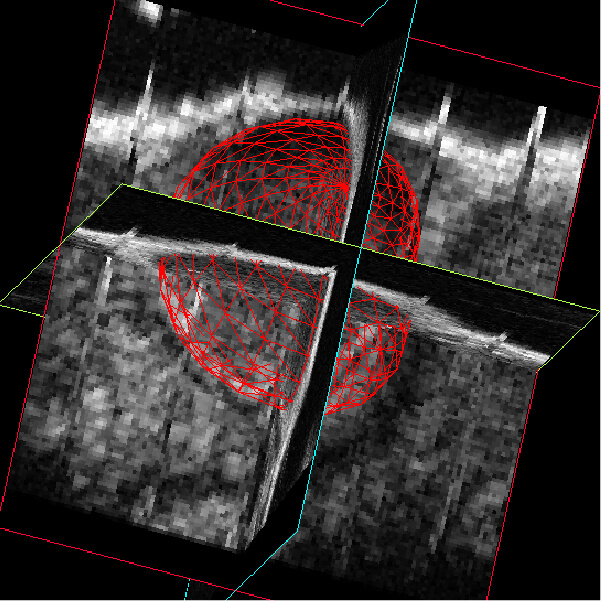
Extensive research facilities that are unparalleled in the world:
In vivo bioluminescence imaging, high-resolution ultrasound imaging, micro X-ray and molecular pathology systems.
Multidimensional analysis is required to increase the credibility of experimental data. In our laboratory, we use tumor cells transformed by molecular biological techniques to determine their behavior in a microenvironment. We analyze bioluminescence, high-resolution ultrasound and micro X-ray CT images, together with molecular pathology data. Few laboratories in the world that can produce results by freely using equipment of such a research scale in one laboratory.
Theme
Research Themes
1.Experimental verification of the theory of lymph node-mediated hematogenous metastasis
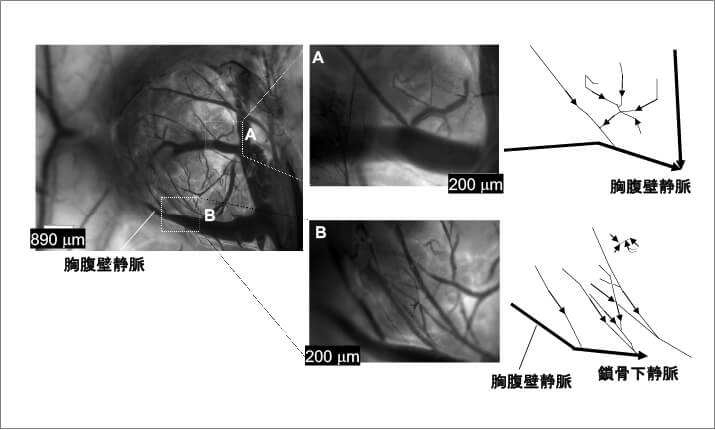
The thoracoepigastric vein runs on the surface of the proper axillary lymph node and anastomoses to the vein from inside the lymph node (left figure). When fluorescent particles are administered to the tail vein, the fluorescent particles flow from the vein in the proper axillary lymph node to the thoracoepigastric vein and finally to the subclavian vein. (Figures I, II). The right figure is a schematic diagram showing the flow of fluorescent particles in Figure I and Figure II.
J Cancer Metastasis Treat 2018;4:56.
Sentinel lymph nodes are lymph nodes where cancer cells first arrive from the primary tumor. The traditional concept of lymph node metastasis is that the tumor cells metastasize to the sentinel lymph node via lymphangiogenesis, enter the lymph nodes sequentially via lymphatic vessels, enter the subclavian vein and finally enters the major organs of the body.
In our laboratory, a new ‘lymph node-mediated hematogenous metastasis theory’ has been advocated in which tumor cells infiltrate veins at the early stage of metastasis in the sentinel lymph nodes and metastasize to major organs throughout the body through the blood circulation. Therefore, it is a crucial issue on how to diagnose and treat sentinel lymph nodes at the early stage of metastasis before tumor cells metastasize from the sentinel lymph nodes to the whole body through the blood circulation.
In this study, we aim to verify this theory experimentally.
We believe that early diagnosis and treatment of sentinel lymph nodes will prevent distant metastasis of tumor cells and improve the survival of cancer patients.
2.New cancer chemotherapy via lymph network
(lymphatic drug delivery: LDDS)
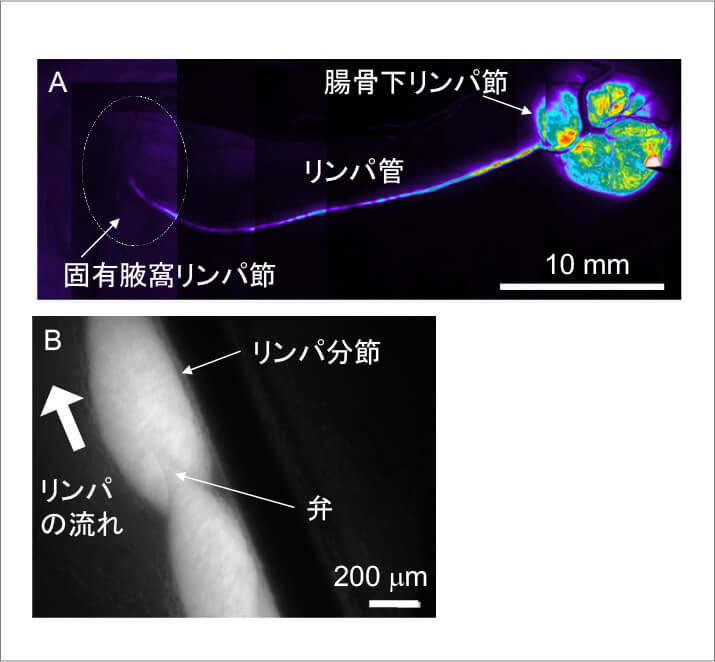
A.Flow of fluorescent dye from the subiliac lymph node towards the proper axillary lymph node. B. Lymph segment and valve.
A lymphatic vessel consists of a series of dozens of ducts called lymphangion. This segment has a valve that prevents the reverse flow of the lymph, so that lymph only flows in one direction. When fluorescent dyes are injected into the subiliac lymph nodes (upstream lymph nodes), they flow from the subiliac lymph node to the proper axillary lymph nodes (downstream lymph nodes) through the lymphatic vessels. Therefore, the injection of anticancer drugs into the sentinel lymph node can be expected to treat tumor cells that have metastasized to the sentinel lymph node and its associated downstream lymph nodes.
Biomed Opt Express. 2015; 6(1):124-34.
Visualization of fluid drainage pathways in lymphatic vessels
The LDSS can treat not only sentinel lymph nodes but also their downstream lymph nodes by injection of drugs into the sentinel lymph nodes. This system is our original method. We expect that we can treat one lymph node at the early stage of metastasis with a tiny amount of anticancer drug. This amount is significantly less than the dose required for systemic chemotherapy. This method can treat patients who have been difficult to apply lymphadenectomy to because of old age or other diseases and to lymph nodes outside the lymphadenectomy region that are difficult to remove by surgery. It is expected to be an epoch-making treatment that can save many cancer patients suffering from the side effects of cancer drugs and lymph node metastasis.
As of November 2018, with the approval of the Pharmaceuticals and Medical Devices Agency (PMDA), Japan, it is in the preparation stage of Phase I clinical trials, aiming for standard treatment* using this method.
*Treatment that has been proven to be the best currently available based on scientific evidence.
3.Studies on activation of tumor cells in distant organs after lymph node dissection
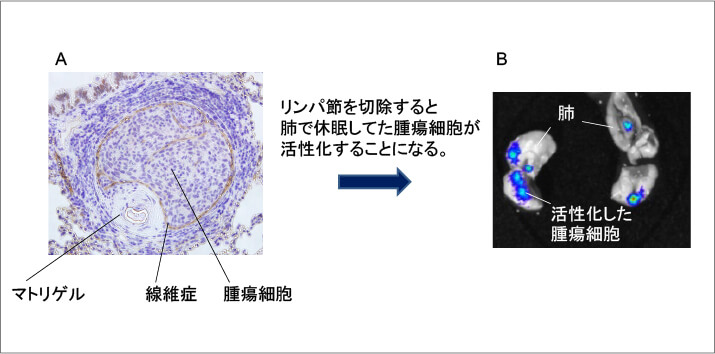
Cancer cells that have spread to the lungs are covered with endothelial cells and lie dormant. When the lymph nodes are dissected, the cancer cells are stimulated to start growing.
Biochem Biophys Res Commun. 2015;460:543-8.
In clinical practice, the removal of metastatic lymph nodes has been reported to activate cancer cells in local and distant organs. We have not fully elucidated the activation mechanisms yet. In our laboratory, we will use the latest technology to clarify the relationship between lymph node dissection and lung metastasis activation using a mouse model of lung metastasis activation developed in our laboratory.